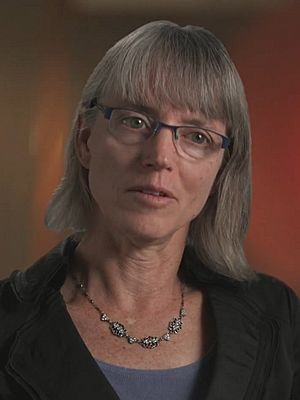Nancy Kanwisher facts for kids
Quick facts for kids
Nancy G. Kanwisher
|
|
|---|---|
 |
|
| Born | 1958 (age 66–67) |
| Nationality | American |
| Alma mater | Massachusetts Institute of Technology |
| Known for | Fusiform face area |
| Awards | Golden Brain Award Heineken Prize Kavli Prize |
| Scientific career | |
| Fields | Cognitive psychology |
| Institutions | UCLA Harvard University Massachusetts Institute of Technology |
| Thesis | Repetition blindness: type recognition without token individuation (1986) |
| Doctoral advisor | Mary C. Potter |
| Doctoral students | Frank Tong |
Nancy Gail Kanwisher (born in 1958) is a leading scientist. She studies how our brains see and think. She is a professor at the Massachusetts Institute of Technology (MIT). She also works as a researcher at the McGovern Institute for Brain Research.
Nancy Kanwisher's Journey in Science
Nancy Kanwisher has a strong background in brain science. She earned her first degree in biology from MIT in 1980. Later, she received her PhD in Brain and Cognitive Sciences from MIT in 1986. After her PhD, she continued her research at UC-Berkeley.
Before joining MIT as a professor in 1997, she taught at UCLA and Harvard University. She helps edit several important science journals. These journals publish new discoveries in how our minds work.
Once, during a lecture, Professor Kanwisher shaved her head. She did this to show her students the different parts of the brain. This helped them understand how each part works.
Awards and Recognitions
Nancy Kanwisher has received many awards for her amazing work.
- In 1999, she won the Troland Research Award. This award is for studies about how our minds and bodies connect.
- She received the MacVicar Faculty Fellow Award in 2002.
- In 2016, she won the National Institutes of Health Director's Pioneer Award.
- The University of York in England gave her an honorary doctorate in 2021.
- She won the NAS Award in the Neurosciences in 2002.
- In 2023, she was awarded the Jean Nicod Prize.
- In 2024, she received the Kavli Prize in neuroscience. This was for finding a special brain area that recognizes faces.
- Also in 2024, she won the Rosenstiel Award from Brandeis University.
Professor Kanwisher helped start the McGovern Institute for Brain Research at MIT. She is also a member of important science groups. These include the National Academy of Sciences and the American Academy of Arts and Sciences. In 2017, she became a Fellow of the British Academy.
How Our Brains See and Think
Nancy Kanwisher is an expert in cognitive psychology. This field studies how our minds work by looking at our behavior. She is famous for discovering the fusiform face area (FFA) in the human brain. This part of the brain helps us recognize faces. It also helps us tell the difference between similar objects.
She also found the parahippocampal place area (PPA). This brain area helps us recognize different places and scenes. These discoveries are very important in brain science. They help us understand how our brains process what we see.
To do her research, she uses special tools. These include functional MRI (fMRI), which shows brain activity. She also uses transcranial magnetic stimulation (TMS). This helps scientists study how different brain parts work. She also uses ECOG to study how we hear, understand language, and interact with others.
In 2014, she gave a popular TED Talk. It was called "A Neural Portrait of the Human Mind."

